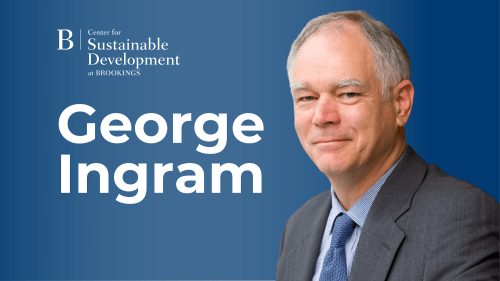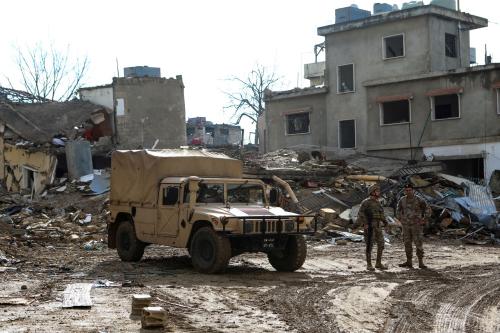The Project on U.S. Relations with the Islamic World (IWR) at Brookings recently hosted a panel of experts on global terrorism to launch a new book tracking the evolution of ISIS from a band of renegade jihadis to a global insurgent movement.
Will McCants, IWR director and senior fellow, moderated a discussion featuring J.M. Berger, nonresident fellow with IWR and founder of Intelwire, and Jessica Stern, lecturer at Harvard University. Berger and Stern shared findings from their book, ISIS: The State of Terror, and discussed a set of fundamental questions about the group’s rise to power, its effectiveness at recruiting followers and capturing media attention, and possible paths for its demise.
Genesis: How did ISIS begin?
The group that now calls itself the Islamic State, Berger noted, came to existence during the early days of the U.S. invasion of Iraq. Conceived by seasoned Jordanian jihadi Abu Musab Zarqawi—notorious in the international jihad scene for his sharp sectarian tendencies—as an anti-American group fighting under its own auspices, the group was later rechristened al-Qaida in Iraq (AQI) after being co-opted by al-Qaida.
The group’s trademark predilection for violence, Stern explained, was evident from its genesis. Zarqawi’s propensity for filming his atrocities against Westerners and Muslims—especially Shia—angered the al-Qaida leadership. Foreshadowing ISIS’s renegade tendencies, Zarqawi disregarded al-Qaida’s admonishments and continued to inflame sectarian violence in Iraq.
Evolution: What enabled ISIS’s rise to power?
Berger explained that AQI gained momentum during the U.S. invasion of Iraq by exploiting sectarian grievances to escalate the anti-American insurgency into a sectarian conflict targeting prominent Shia. The group would instigate chaos by sparking a chain reaction of violence; for example, an AQI-led bombing at a Shiite mosque would initiate a series of retaliations, resulting in numerous deaths and growing instability.
AQI did not just target Shia, Berger explained, but was the also main source of U.S. casualties during the Iraq war. While U.S. counter-insurgency efforts significantly thinned its ranks, the group resurged amidst the power vacuum left by the U.S. exit from Iraq, and the subsequent instability in Syria. The group’s self-christening as the Islamic State, Berger noted, was not merely a “rebranding” but indicative of how it intended to redefine the global jihad.
Impact: Why is ISIS so successful?
The panelists attributed ISIS’s success to a unique self-projection propagated on strength, which is disseminated through a persistent and in many ways skillful media strategy. ISIS has overturned the traditional jihadi narrative of weakness and oppression of Muslims against a tyrannical West, replacing it with one of strength and victory. Berger, who authored a recent Brookings paper on ISIS’s use of Twitter, explained how ISIS retooled traditional al-Qaida propaganda to incorporate sleek, modern technologies and narrative storytelling emphasizing victory.
Stern noted the group resembles a nationalist movement in its marketing strategy and structure. ISIS, she explained, has developed a mechanism to “create a new human being” capable of horrific violence. The group emphasizes its own power through highly visual displays of violence alongside a portrayal of life in a functioning state entity that welcomes not just fighters, but doctors, wives, and other professions. These projections, Stern explained, strongly appeal to potential recruits seeking to reinvent themselves and possess a clear identity.
ISIS’s endgame: What are the possible outcomes?
Stern and Berger agreed that all the policy options available to the international community are unattractive. While both panelists advocated against the use of U.S. ground forces to counter ISIS, Berger urged Washington and the international community to use all available tools to creatively combat ISIS. He suggested closely targeting points that cut road access between key ISIS cities and disrupting the group’s Internet access and infrastructure. Berger emphasized that a stalemate represents a victory for ISIS, allowing the group time to expand its global influence.
The panelists also addressed the theory that ISIS will bring about its own downfall through its brutality. Stern and Berger agreed that while this represents a possible outcome, waiting for the group to collapse would likely generate an enormous humanitarian loss in the meantime. Berger concluded that any scenario to combat ISIS will incur a significant human cost, and will likely involve the entire region.
The Brookings Institution is committed to quality, independence, and impact.
We are supported by a diverse array of funders. In line with our values and policies, each Brookings publication represents the sole views of its author(s).



Commentary
ISIS and the state of terror: The genesis, evolution, and impact of the Islamic State
April 3, 2015